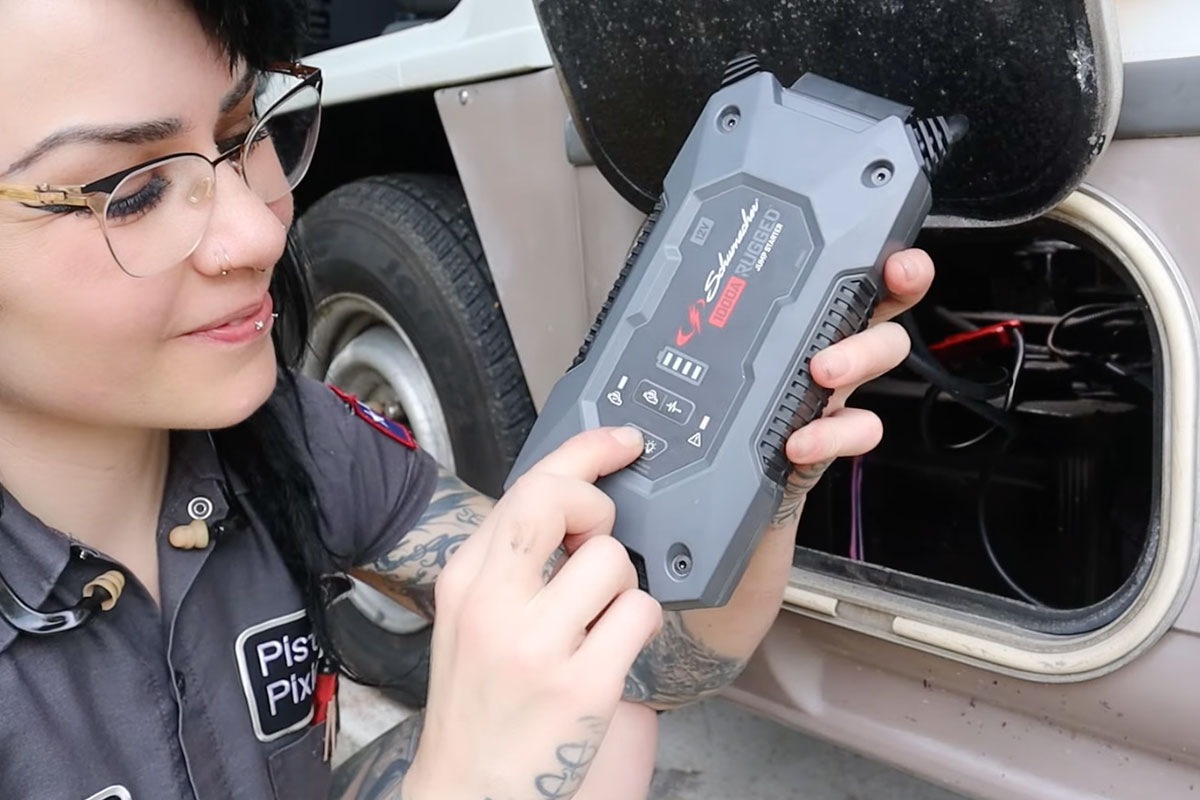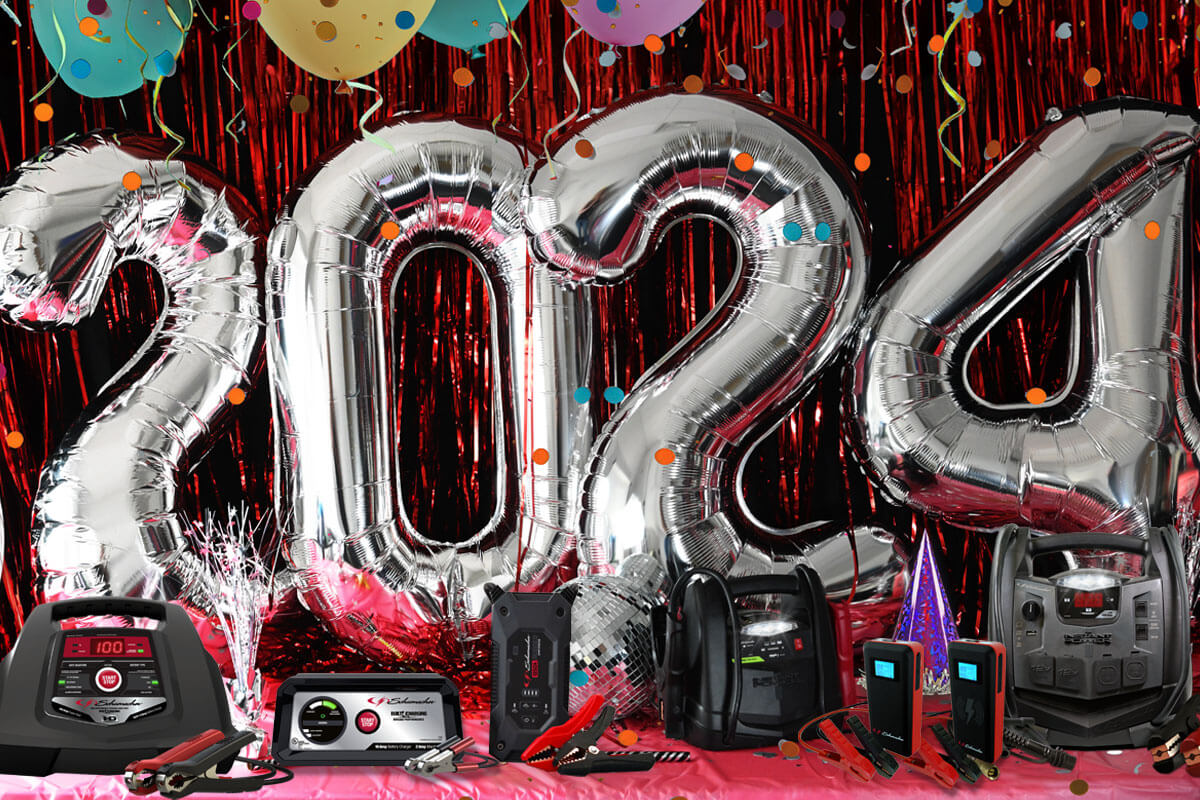Rev Up for Spring: Preparing Your Outdoor Recreation and Maintenance Vehicles for Action!
As the winter chill fades away and spring bursts into full bloom, it’s time to dust off your outdoor motorized toys and get ready for some outdoor fun! From ATVs and personal watercraft to motorcycles and boats, your collection of recreational vehicles holds the promise of adventure and excitement. However, after a season of hibernation, […]

As the winter chill fades away and spring bursts into full bloom, it’s time to dust off your outdoor motorized toys and get ready for some outdoor fun! From ATVs and personal watercraft to motorcycles and boats, your collection of recreational vehicles holds the promise of adventure and excitement. However, after a season of hibernation, it’s essential to ensure that your vehicles are in top-notch condition for optimal performance. In this blog, we’ll explore the vital role of battery chargers, battery maintainers, and jump starters in getting your marine and power sport vehicles revved up and ready for action this spring.
Assessing Battery Health: The Key to a Smooth Start
Before you can hit the trails or cruise the waves with your favorite rides this spring, it’s crucial to ensure that your vehicle’s battery is in optimal condition. Whether you’re dealing with a 6-volt battery in your child’s ride-on toy or a 12-volt battery in your ATV, a smooth start begins with a healthy battery. Here are some essential steps to assess the health of your batteries and ensure they’re ready for action.
Visual Inspection
Start by visually inspecting the battery for any signs of damage or corrosion. Look for cracks, leaks, or bulges in the battery casing, as these could indicate internal damage or electrolyte leakage. Additionally, check the battery terminals for corrosion or buildup, which can hinder electrical conductivity.
Voltage Check
Using a multimeter or voltage tester, measure the voltage of the battery to determine its health. For 6-volt batteries, any reading below 6 volts is suspect, while for 12-volt batteries, it should not read below 12 volts.[1] If the voltage falls below these levels, it may indicate a discharged or weak battery that requires charging or replacement. However, keep in mind that lead-acid battery voltage can vary based on variables such as ambient temperature and battery type.[2]
Load Testing
Perform a load test on the battery to assess its ability to deliver power under a simulated load. This test helps identify weak or failing batteries that may not hold a charge or provide sufficient power to start the vehicle. Many automotive supply stores offer load testing services, or you can invest in a battery load tester, such as the Schumacher BT-100, for home use.
Battery Age
Consider the age of the battery when assessing its health. Most lead-acid batteries outdoor recreation vehicles have a lifespan of around 3 to 5 years[3], depending on usage and maintenance. If your battery is approaching or exceeding this timeframe, it may be prone to failure and should be replaced as a preventative measure.
Electrolyte Levels
For batteries with removable caps, such as flooded lead-acid batteries, check the electrolyte levels and ensure they are within the manufacturer’s recommended range. Low electrolyte levels can lead to reduced battery performance and lifespan, so top up the electrolyte with distilled water if necessary.
Professional Inspection
If you’re unsure about the condition of your battery or if it’s exhibiting signs of failure, consider seeking a professional inspection from a certified mechanic. They can conduct a comprehensive assessment and recommend appropriate steps for repair or replacement.
By carefully assessing the health of your power sport, motorized toy, or marine battery before springing into action, you can avoid unexpected breakdowns and enjoy uninterrupted fun in the great outdoors. Remember, a little preventative maintenance goes a long way in ensuring a smooth start to your spring adventures!
Charging Up: The Importance of Battery Chargers
When it comes to getting ready for springtime adventures, one of the most crucial steps is ensuring that your vehicles’ batteries are fully charged and ready to go. Whether you’re charging up your children’s ride-on toys, revving up your ATV, or prepping your personal watercraft for some fun on the water, a reliable battery charger is your best friend. Here’s why regular battery charging is so important and how the right battery charger can make all the difference:
Preserving Battery Life
Batteries, whether 6-volt or 12-volt, are essential components of any motorized vehicle, and proper charging is key to preserving their lifespan. By maintaining the correct charge level and avoiding deep discharges, you can significantly extend the life of your batteries and ensure they provide reliable power season after season.
Preventing Dead Batteries
There’s little worse than eagerly anticipating a day of outdoor fun, only to find that your dirt bike won’t start due to a dead battery. Regularly charging your batteries with a dedicated battery charger helps prevent this scenario by keeping them topped up and ready for action. A good all-around battery charger to consider is the Schumacher SC1344 Wireless Fully Automatic Battery Charger and Maintainer. It features wireless monitoring and is compatible with 6-volt and 12-volt batteries.
Faster Charging Times
While some vehicles, such as children’s ride-on toys, may come with battery chargers, they often have limited charging capabilities and can take a long time to fully charge a battery. Investing in a high-quality battery charger specifically designed for 6-volt or 12-volt batteries can significantly reduce charging times, allowing you to get back to enjoying your toys more quickly. For example, Schumacher’s Charge ‘n Ride CR5 3-Amp 6-Volt/12-Volt Universal Battery Charger for Ride-on Toys charges three times faster than many included chargers.
Versatility and Compatibility
Not all battery chargers are created equal, and choosing the right charger is essential. Look for a charger that is compatible with your specific vehicles’ battery voltage or purchase a dual 6-volt/12-volt charger to accommodate the various vehicles. Additionally, opt for a charger with adjustable charging rates or multiple charging modes to suit different battery types and sizes. A good choice is the Schumacher SC1281 Fully Automatic Battery Charger and Jump Starter, which is compatible with standard, AGM, gel, and deep-cycle batteries and features fully automatic operation and an internal microprocessor that automatically detects the voltage of connected batteries and adjusts the amperage rate during charging.
Maintenance Charging
In addition to charging batteries from a discharged state, many modern battery chargers also offer maintenance or trickle charging modes, so you don’t need to purchase a separate battery maintainer. These modes deliver a low, constant charge to the battery, helping to prevent self-discharge and sulfation, which can occur when batteries sit unused for extended periods. For example, the Schumacher SC1444 Two-Bank Battery Charger and Maintainer can charge and maintain two batteries at once and employs float mode monitoring to maintain batteries after charging is complete.
Safety Features
When selecting a battery charger, prioritize safety features such as overcharge protection, short-circuit protection, and reverse polarity protection. These features help safeguard both your batteries and your vehicles against potential damage or accidents during the charging process. The Schumacher SC1319 Fully Automatic Battery Charger and Maintainer features an array of safety features designed to protect you and your vehicle.
By recognizing the importance of charging up your vehicle batteries with a reliable battery charger, you can ensure they’re always ready to go when adventure calls. Don’t let dead batteries put a damper on your springtime fun—charge up and rev up for endless hours of outdoor excitement!
Maintaining Power: The Role of Battery Maintainers
Battery maintainers play a crucial role in keeping your vehicles’ batteries healthy and ready for action, especially during periods of storage or infrequent use. Unlike traditional battery chargers, which deliver a bulk charge to bring a battery to full capacity, battery maintainers provide a low, constant charge to keep batteries topped up without overcharging or damaging them.
Benefits of Battery Maintainers
- Long-Term Battery Health: By maintaining a constant charge level, battery maintainers help prevent sulfation and self-discharge, two common causes of battery failure.
- Convenience: Battery maintainers are designed for set-it-and-forget-it operation, making them ideal for use during extended periods of storage or when maintaining multiple batteries.
- Compatibility: Many battery maintainers are compatible with both 6-volt and 12-volt batteries, making them suitable for a wide range of recreational outdoor vehicles. For example, the CRAFTSMAN CMXCESM259 Automatic Battery Charger and Maintainer works with standard, AGM, gel, and deep-cycle 6-volt and 12-volt batteries.
- Versatility: Some battery maintainers offer additional features such as desulfation modes or bad battery detection, further extending their usefulness throughout the year.
How to Use a Battery Maintainer[4]
- Connect the Maintainer: Simply connect the battery maintainer to your vehicle’s battery using the provided cables and connectors.
- Select the Mode: Depending on the maintainer model, choose the appropriate charging mode or setting for your battery type and size. Fully automatic maintainers may choose the optimal charging modes without user input.
- Set It and Forget It: Once connected, the battery maintainer will automatically monitor and maintain the battery’s charge level, ensuring it stays in optimal condition.
Ready for Anything: The Lifesaver That Is a Jump Starter
A jump starter is a must-have tool for anyone who owns any type of vehicle with a starter battery, providing peace of mind and a quick solution in the event of a dead battery. Whether you’re stranded on a trail with your ATV or stalled on the water with your personal watercraft, a reliable jump starter can get you back up and running in no time.[5]
Features of Jump Starters
- Portable Power: Most jump starters are compact and lightweight, making them easy to carry in your vehicle or store onboard your boat.
- Multi-Functionality: In addition to jump starting vehicles, many jump starters also feature built-in LED flashlights, USB charging ports, and even air compressors for added convenience. Schumacher’s SL1639 Portable Power Pack and Jump Starter features 1000-amp jump starting, a 2.4-amp USB port that will charge a range of devices, and a three-mode LED light.
- Safety: Modern high-quality jump starters, such as those manufactured by Schumacher, incorporate safety features such as reverse polarity protection and spark-proof technology to prevent accidents and protect both the user and the vehicle.
- Jump Starting, Charging, and Maintaining: An all-in-one battery charger, battery maintainer, and jump starter is a smart addition to your garage. These combination units, such as the Schumacher Pro SPR1629 Battery Charger, Engine Starter, and Maintainer features a range of functions and charging modes for full-service battery care.
How to Use a Jump Starter[6]
- Connect the Cables: Determine whether the vehicle is negative grounded or positive grounded.[7] For negative ground vehicles, attach the positive (red) clamp to the corresponding positive terminal on the dead battery and connect the negative (black) clamp to the vehicle chassis or engine block, ensuring a secure connection.
- Power On: Turn on the jump starter and wait for it to indicate that it’s ready to deliver power.
- Start the Engine: Once the jump starter is ready, attempt to start the vehicle as you normally would. If successful, disconnect the jump starter and allow the engine to run to recharge the battery.
Spring Maintenance Tips for Various Motorized Toys
As you prepare to unleash your outdoor motorized toys for springtime fun, it’s essential to perform some basic maintenance tasks to ensure they’re in top condition and ready to hit the road or water. Here are some spring maintenance tips for common types of power sports and other outdoor recreation vehicles.
ATVs, Dirt Bikes, and Four-Wheelers
- Inspect Tires: Check tire pressure and tread depth. Then replace any worn or damaged tires.
- Fluid Check: Inspect oil, coolant, and brake fluid levels, and top up or replace as needed.
- Clean Air Filter: Remove and clean the air filter, or replace the filter, if necessary, to ensure optimal engine performance.
Personal Watercraft and Boats
- Inspect Hull: Check the hull for cracks, chips, or other damage, and repair as needed to prevent water intrusion.
- Check Safety Equipment: Ensure that life jackets, flares, fire extinguishers, and other safety equipment are in good condition and readily accessible.
- Test Electronics: Verify that navigation lights, depth finders, and other electronic equipment are functioning correctly.
Ride-On Toys and Golf Carts
- Check Battery: Inspect the battery for signs of corrosion or damage, and ensure it is fully charged and ready for use. If the battery needs replacement, check out Schumacher’s Charge ‘n Ride replacement ride-on toy batteries, such as the TB1, TB3, and TB4.
- Inspect Wheels: Check wheels and tires for damage. Next lubricate axles and moving parts to ensure smooth operation.
- Safety Check: Verify that all safety features, such as seatbelts and brake systems, are in good working order.
Safety First: Essential Precautions When Working with Batteries
Working with batteries, whether charging, jump starting, or performing maintenance, requires caution and attention to safety to prevent accidents and injuries. Here are some essential precautions to keep in mind when working with batteries:
- Wear Protective Gear: Always wear protective gear, including gloves and safety glasses, to shield against acid spills and electrical hazards.
- Avoid Sparks: When connecting or disconnecting cables, ensure they are properly insulated and avoid creating sparks, which could ignite battery gases.
- Follow Manufacturer Instructions: Read and follow the manufacturer’s instructions for all battery chargers, maintainers, and jump starters to ensure safe and proper operation.
- Ventilation: Work in a well-ventilated area to prevent the buildup of potentially hazardous battery gases, such as hydrogen sulfide.[8]
Enjoying Spring Adventures: Hit the Road (or Water) with Confidence!
With your outdoor recreation vehicles charged up, maintained, and ready to go, it’s time to embark on springtime adventures with confidence. Whether you’re exploring off-road trails on your ATV, cruising the waves on your personal watercraft, or enjoying a leisurely round of golf in your cart, the possibilities for outdoor fun are endless. So, grab your gear, buckle up, and get ready to make memories that will last a lifetime!
[1] “How to Test a Car Battery with a Multimeter,” AutoZone, https://www.autozone.com/diy/battery/how-to-test-a-car-battery-with-a-multimeter, Accessed 7 March 2024.
[2] Beale, Alex, “Lead Acid Battery Voltage Charts (6V, 12V, & 24V),” Footprint Hero, https://footprinthero.com/lead-acid-battery-voltage-charts, Accessed 7 March 2024.
[3] “How Long Do Car Batteries Last,” AAA, https://www.aaa.com/autorepair/articles/how-long-do-car-batteries-last, Accessed 7 March 2024.
[4] Note: Always read and follow all instructions in the manufacturer’s user manual.
[5] Note: Marine batteries should be returned to shore before charging or engine starting.
[6] Note: Always read and follow all instructions in the manufacturer’s user manual.
[7] Nearly all vehicles manufactured since the early 1960s are negative ground.
[8] “Lead Acid Batteries,” Concordia University, https://www.google.com/url?sa=t&rct=j&q=&esrc=s&source=web&cd=&ved=2ahUKEwjupe7g7eKEAxWOIEQIHaq0DnEQFnoECDEQAQ&url=https%3A%2F%2Fwww.concordia.ca%2Fcontent%2Fdam%2Fconcordia%2Fservices%2Fsafety%2Fdocs%2FEHS-DOC-146_LeadAcidBatteries.pdf&usg=AOvVaw11IZcsA6PqiLswYiTAibhl&opi=89978449, Accessed 7 March 2024.




